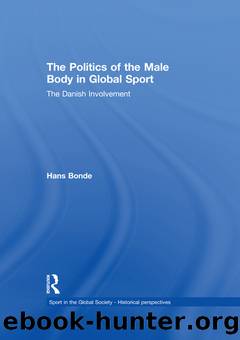The Politics of the Male Body in Global Sport by Hans Bonde

Author:Hans Bonde [Bonde, Hans]
Language: eng
Format: epub
Tags: Sports & Recreation, General, Gymnastics, Cultural & Social Aspects
ISBN: 9781317966029
Google: 0bWMAQAAQBAJ
Barnesnoble:
Publisher: Routledge
Published: 2013-10-18T00:52:29+00:00
Nazism and Homosexuality
It might seem strange that Niels Bukh, a homosexual, could be an avid supporter of a system that would carry out the modern worldâs most barbaric assault on homosexuals and the elimination of a very strong homosexual culture that was found in the large cities of the Weimar Republic. From a photograph it can be seen that Bukh clearly found it no problem to be shown around Berlin by a member of the Nazi SA, arm-in-arm with his former partner, Krogshede.
Bukhâs âvisitâ to Berlin took place, however, at a point when the Nazi terror against homosexuals was still in an embryonic state, and in the SA in particular there was a good deal of tolerance for homosexual friendships. But the reason for Hitlerâs liquidation of the SA leaders in the so-called Röhmputsch was given as widespread homosexuality among the corps, and this sounded a starting-pistol for an extremely violent persecution of homosexuals. Bukhâs visit occurred before that ânight of the long knivesâ, which took place on 30 June 1934. [26] Bukh may therefore have gained the impression that Nazism had less of a homophobic attitude than in reality it proved itself as having. Perhaps the Nazi pursuit of male fellowship gave Bukh the feeling that, here, he was not an outsider but an integrated part of the peopleâs fellowship.
In fact there was an ambiguity in the Nazi conception of intense relations between men, which on the one side was emphatically heroic but which on the other side certainly led to persecution as soon as the relationship crossed over into homosexuality. [27] The Nazi ideology contained a revolt against the cold, calculating relationships between men in bourgeois society. Instead, a strong feeling of loyalty, idealism and self-sacrifice was to be cultivated among groups of comrades, which was an essential building block for a military upbringing, and which was placed on a par with all-male societies earlier in history, such as the Knights Templars. [28] Therefore, the Nazi hatred of the Freemasonsâ fraternity should be seen against the background that it was regarded as a cosmopolitan, liberal, instrumental and class-divided bourgeois organization, and was in competition with the Nazi idea of Ma¨nnerbund, or a league of men, such as the SS and the SA. [29] The artist Josef Thorak was most instrumental in the visual mediation of heroic comradeship in the Third Reich.
The notion of comradeship also played a crucial role in Bukhâs gymnastics, not least in two menâs intense collaboration in the very physically demanding and aesthetic working in pairs. To provide a symbol of comradeship, Bukh had a statue set up in 1937, called âFellowshipâ, which according to Bukh portrayed âtwo young men hurrying forward. The one has momentarily stumbled but the other stretches out a helping hand, while he continues to point forward towards the goal that they both struggle to attainâ. [30]
It may well have been that Nazism could have developed along lines that accepted actual male homosexuality, in much the same manner as the classical
Download
This site does not store any files on its server. We only index and link to content provided by other sites. Please contact the content providers to delete copyright contents if any and email us, we'll remove relevant links or contents immediately.
Shoe Dog by Phil Knight(5085)
The Rules Do Not Apply by Ariel Levy(4795)
Walking by Henry David Thoreau(3863)
How to Read Water: Clues and Patterns from Puddles to the Sea (Natural Navigation) by Tristan Gooley(3376)
Running Barefoot by Amy Harmon(3373)
I'll Give You the Sun by Jandy Nelson(3333)
Crazy Is My Superpower by A.J. Mendez Brooks(3277)
How to Read Nature by Tristan Gooley(3217)
How Music Works by David Byrne(3088)
The Boy, the Mole, the Fox and the Horse by Charlie Mackesy(2931)
The Fight by Norman Mailer(2807)
Seducing Cinderella by Gina L. Maxwell(2582)
Cuba by Lonely Planet(2533)
Accepted by Pat Patterson(2271)
Going Long by Editors of Runner's World(2257)
The Unfettered Mind: Writings from a Zen Master to a Master Swordsman by Takuan Soho(2208)
The Happy Runner by David Roche(2171)
Backpacker the Complete Guide to Backpacking by Backpacker Magazine(2155)
Trail Magic by Trevelyan Quest Edwards & Hazel Edwards(2109)
